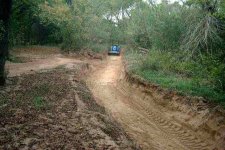</font><font color="blue" class="small">( I load the bucket up against a bank so I get it almost full everytime, the dry sand it will load, but if I get any wet sand in with it, it won't lift it over the side, so I'm most likely at the load limit. )</font>
That's exactly the way my loader works too. I can lift a heaped wet sand load up to about 3' - 5', but the loader's hydraulics will stall if I try to go higher. I've been thinking of checking my pressure, but I know a half yard of wet sand weighs near the limit of my loader, so I'm not all that concerned. If your loader is stalling with less than a heaping load, it might be a good thing to have your pressure checked the next time you have your tractor serviced.
I really didn't answer your question about the difference between warm and cool hydraulic fluid. On a positive displacement pump where there is no leakage, there should be very little difference between cool and hot fluid related to maximum pressure. There is a difference related to flow rate. The lower viscosity warm fluid will flow at a higher rate than the thicker cool fluid. If you have a pressure relief valve set at 2000 psi, it will take 2000 psi in either hot or cool fluid to lift the relief valve. The difference is how fast the fluid will flow through the valve once it opens. The hotter the fluid, the more will flow.
Having said that, I think a piston type hydraulic pump is more effecient than a vane type pump because I believe all vane pumps do have some leakage and the viscosity of the fluid would effect that. With either pump, it's advertised pressure and flow will be within a specific operating range of temperatures and rpm. Once you are in that range, the characteristics should be stable. So, from cool to warmup, you might experience some change. Winter operation would probably be the most dramatic.
Having said that, I often feel like by the end of the day that my tractor isn't doing things quite fast enough. But that's probably because I'm tired and hungry and want to get done. /forums/images/graemlins/smile.gif
Here's a photo of a creek on my property that I cleaned out last year. In this photo you would be hard-pressed to see where any creek/ditch is because it has completely silted-in with sand. My property is on the left and my neighbor's property is on the right. The creek is the dividing line. /forums/images/graemlins/confused.gif

